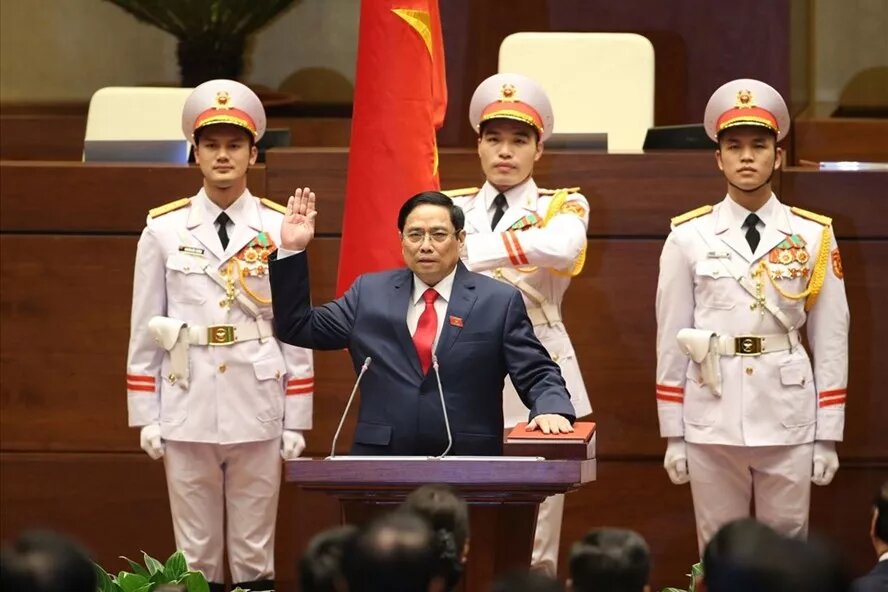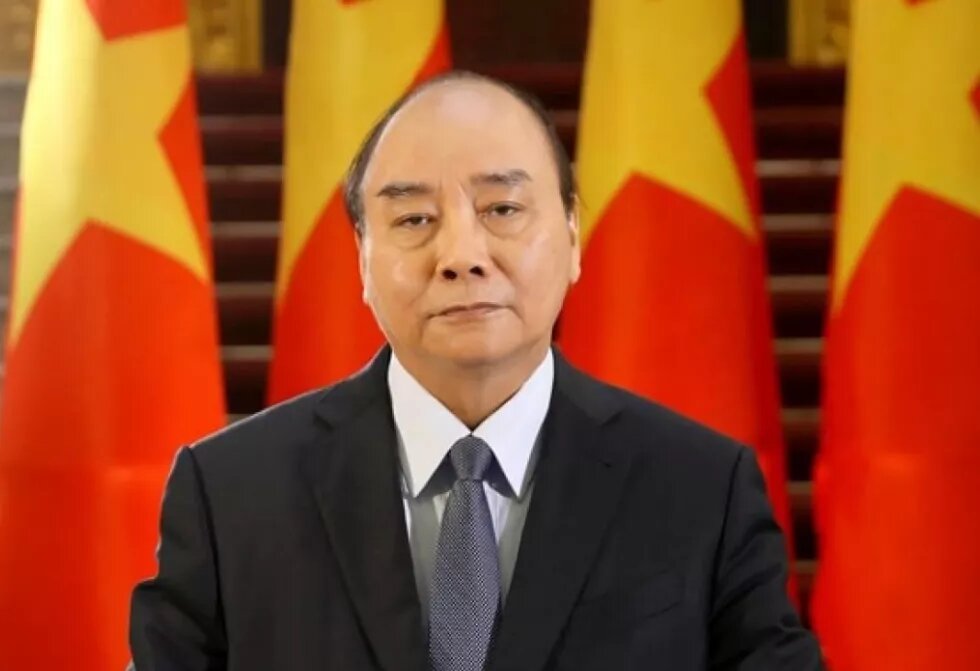
The 13th National Congress of the Communist Party of Vietnam (CPV) had the potential to be the most consequential congress since 1986, when the party adopted the Doi Moi reforms that began Vietnam’s opening to the world. The most recent congress, convened during the first quarter of 2021, came during a time of unique global crisis and uncertainty. Would party members respond by selecting younger more dynamic leadership and national policies, or would they stick with a veteran group of leaders and their tried-and-true prescriptions for the next five years? Expectations for change were high.

The advent of COVID-19, a once-in-a-century pandemic, weighed heavily on those in attendance. The virus and measures to contain it have paralyzed the globe, economies and trade, and affected nearly every aspect of life. The pandemic provided a dismal coda to Vietnam’s three decades of economic and political progress. That progress was built on international cooperation. However, COVID-19 altered the global landscape. The pandemic contributed to intensifying the great power competition between the United States and China, making the international environment less conducive for the cross-border cooperation so needed for the global recovery.
Vietnam is governed by a collective leadership system. Guided by “democratic centralism,” power is divided among four top positions. This system is designed to prevent any one person from accumulating too much authority. The four top positions are: The Party Secretary General, who leads the CPV and wields the most power of all; the President, who is the head of state but whose role is largely ceremonial; the Prime Minister, who exercises the executive power of the government, and the Chairperson of the National Assembly, who leads the legislature.
The CPV refers to this as the “four-pillar model.” However, an unfortunate turn of events reduced this to “three pillars.” Among several issues this Congress considered that were more unusual than previous issues was whether the leadership would return to the “four-pillar model” or continue to consolidate power in “three pillars.”
In 2016, the 12th Party Congress re-elected Nguyen Phu Trong as the Party Secretary General. The CPV also elected former public security minister Tran Dai Quang as President, Nguyen Xuan Phuc as Prime Minister, and Nguyen Thi Kim Ngan as Chairperson of the National Assembly. Ngan was the first woman to hold that post or any of the top four positions. Then, in September 2018, President Tran Dai Quang unexpectedly passed away while in the office. In an unprecedented move, the CPV’s Central Committee unanimously decided that Secretary Trong would also assume the role of president. It was a surprising turn of events. Secretary Trong had been in the top position since 2011, and was only supposed to hold the post for half a term. Due to the existing age limit of 65, he was not eligible to run in 2016. Trong secured an exemption from that rule. But a fierce competition for the job developed between Trong and former Prime Minister Nguyen Tan Dung. Trong emerged as the victor, but he assumed the role with an apparent unwillingness and, he said, only for half the term. However, when the half-term deadline arrived, Trong didn’t step back. Instead, he held on to two of the four most powerful positions in the country. All the while, he was suffering from health issues.
Another unprecedented outcome of the 2016 congress was the exceptionally high number of new members of the Politburo. This was mainly the result of a large number of existing members having reached the age limit. Other reasons for vacancies included an ongoing anti-corruption campaign that culminated with Minister of Transport Dinh La Thang stripped of his rank. Two other openings arose when member Dinh Then Huynh retired because of health issues, and President Tran Dai Quang passed away. That created a situation in which half of those in the remaining 16 positions would exceed the age limit during the five-year term. The CPV Secretariat faced a similar scenario with half of its 14 members slated to reach the age limit. The greying of leadership laid the groundwork for possibly the largest rejuvenation of the party in its history at the next congress.
During the 13th Party Congress that opportunity for revitalization did not materialize. The newly elected 18-member Politburo, hardly reflects generational change. The median age of its members is 63, suggesting many would reach the age limit for re-election during this term.
Nguyen Phu Trong, re-elected for a third term, not only broke the age-limit rule, but also the norm of a two-term limit. Despite his poor health and less public visibility, Trong is understood to still be the main driver of the party’s decision-making process. The Secretary-President disappeared from the public eye for nearly a month in 2019. Suspicion was rife that he had suffered a stroke, making many nervous about the succession and the possibility of the leader being incapacitated. Since then, Trong has had recurring health issues. Rumors frequently swirl about his weakening grip on power. Nonetheless, the 76-year-old has continued to prove those rumors wrong.
Trong’s continuation hardly surprised anyone: the list of the top four names was leaked in January at the last pre-congress plenum. In May, the National Assembly voted to confirm the remaining three positions as predicted: Prime Minister Phuc became the President; Pham Minh Chinh, head of the Party Central Committee’s Organization Commission, became Prime Minister, and Vuong Dinh Hue, Secretary of the Hanoi Party Committee and a former Deputy Prime Minister, became Chairperson of the National Assembly. Hue’s election to head the legislature was a ‘sideways’ move as opposed to a promotion. His government experience qualified him for the post of Prime Minister.
Another norm disregarded at the 13th Party Congress was that of balanced geographical representation. None of the top four leaders are from the southern provinces. All hail from the northern and central regions. The congress elected just one woman, while the previous Politburo had three, another letdown for many.
Commentators were disappointed that Nguyen Xuan Phuc did not win the top position, and his Deputy Prime Minister Vu Duc Dam was not even elected to the Politburo. Together, they have been the face of Vietnam’s impressively effective response to COVID-19. Under Prime Minister Phuc the Vietnamese economy continued to prosper and modernize through his adoption of the Fourth Industrial Revolution as the key direction. Even during the COVID-19 pandemic, Vietnam managed to keep its growth rate steady at 5 to 6 percent after the record 7-percent average of the previous two decades. During the past decade, the country’s GDP doubled, reaching USD 262 billion in 2019. Vietnam is one of few countries in Southeast Asia that managed to escape contraction. While growth in 2020 is estimated at 1.8 percent to 2.5 percent, expectations are for a bounce back to 6.5 percent in 2021, higher than expected before the pandemic.
The results of the 13th Party Congress showed the dominance of party loyalists over state executives who went unrewarded for their competence, capabilities and performance. The election of an exceptionally high number of military and public security representatives suggests that the CPV is betting on loyalty to ideology and party, rather than modernizing its leadership. Out of 200 members of the 13th Central Committee, 120 were re-elected and 80 were newly elected. Fewer women are represented this term: 19 in the Central Committee and only one in the Politburo. Should the top four positions be confirmed as expected, no woman will hold one of the main leadership posts. The usual convention of balanced geographical representation among top leaders to fully reflect the northern, central and southern regions of the country was not adhered to this term. Of the 18 Politburo members, 13 represent party interests, including provincial CPV heads and mass organization heads. This is one of the strongest party representations in recent Politburos.
The country’s economic and diplomatic successes have lent legitimacy to the CPV’s continued hold on the levers of power. This has been true at home and abroad: Australia’s Lowy Power Index cited effective policies when raising Vietnam’s ranking by two places. Building on the confidence gained from the country’s resilience during the pandemic, the 13th Party Congress set some ambitious goals: to become a middle-high income country by 2030, and a high-income country by 2045.
A country with great potential and relative political stability should have ambitious goals. But those goals will be harder to achieve as long as the global outlook remains grim. The current wave of new virus strains (including the Delta variant from India) are wreaking havoc in the region and present a real threat to Vietnam’s successful containment of the virus to date. Prolonged, continuous and repetitive lockdowns, both domestically and internationally, would stress any country’s capacity and resilience. Vietnam’s vaccine rollout has been slow, putting the country at high risk as the virus continues to mutate and resurge. The outlook for regional economies, with which Vietnam is closely interconnected, is even more pessimistic. How long it will take for those economies to recover is uncertain but unlikely to be quick. Vietnam, or any other country for that matter, won’t fully rebound unless its trading partners and markets have also returned to health.
Moreover, to achieve those ambitious goals, the country needs to realize its high potential, maintain good momentum for progress, and, most importantly, make the most of its talent, technocrats and strong human resources. Vietnam faces unprecedented challenges from the COVID-19 pandemic amid the great power competition and continuous challenges to its growing national power from the coercive practices of China. But it has also been presented with unique opportunities from the shift in global supply chains resulting from the pandemic. Tech giants such as Samsung, Intel, Apple and Foxconn are ready to invest in new locations to diversify their production bases. Vietnam wants to become a manufacturing hub for the region. The party’s economic blueprint discussed at the congress also committed to continuing its trade policies and expanding export markets to capitalize on the recent bilateral free trade agreements with the European Union and the United Kingdom, and the multilateral Regional Comprehensive Economic Partnership (RCEP) and Comprehensive and Progressive Agreement for Trans-Pacific Partnership (CPTPP) trade agreements.
The main challenge for Vietnam is how to navigate the uncertain future while benefitting from good demographics. The demographics are changing, as Vietnam will soon have a rapidly aging population. Currently, the people over 60 constitute of around 12% of the population, by 2040 it is projected to be 21%, and by 2050 it will be nearing 40%. There is a level of disconnect between a senior and rather conservative top political leadership and a young, dynamic and vibrant population that is keen to engage globally, and is innovative in its economic profile. The post-COVID-19 era is likely to have many other external challenges that require an adaptive and visionary government. The CPV cannot afford to be entirely pre-occupied with its anti-corruption campaign and internal politicking.
__
Dr. Huong Le Thu is a senior analyst at Australian Strategic Policy Institute (ASPI), Defence and Strategy Program. She is also a Non-resident Fellow with The Southeast Asia Program at Center for Strategic and International Studies (CSIS) Washington, DC.
The views expressed in this article are not necessarily those of Heinrich Böll Stiftung.




